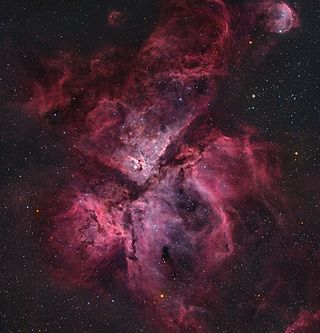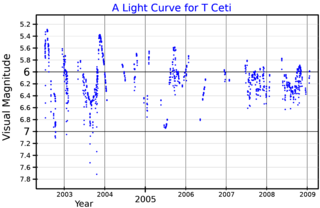
Gamma Trianguli Australis, Latinized from γ Trianguli Australis, is a single, white-hued star in the southern constellation of Triangulum Australe. Along with Alpha and Beta Trianguli Australis it forms a prominent triangular asterism that gives the constellation its name. It is the third-brightest member of this constellation with an apparent visual magnitude of +2.87. Based upon parallax measurements, Gamma Trianguli Australis is located at a distance of about 184 light-years from Earth.

Delta Trianguli Australis, Latinized from δ Trianguli Australis, is a solitary, yellow-hued star in the constellation Triangulum Australe. It has an apparent magnitude of 3.84, making it readily visible to the naked eye under ideal conditions, Parallax measurements place the object at a distance of 606 light years. It has a heliocentirc radial velocity of −4.9 km/s, indicating that it is drifting towards the Solar System.

Kappa Trianguli Australis is a star in the constellation Triangulum Australe.

Iota Trianguli Australis is a binary star system in the constellation Triangulum Australe. It is visible to the naked eye with a combined apparent visual magnitude of +5.27. Based upon an annual parallax shift of 25.77 mas as seen from the Earth, it is located around 127 light years from the Sun. The system appears to be moving closer to the Sun with a radial velocity of around −6 km/s.

θ Trianguli Australis, Latinized as Theta Trianguli Australis, is a single star in the southern constellation of Triangulum Australe. It is visible to the naked eye as a dim, yellow-hued star with an apparent visual magnitude of +5.50. The star is located about 334 light years from the Sun based on parallax, and is drifting further away with a radial velocity of +10 km/s.
Eta Trianguli Australis is a solitary, blue-white hued star in the southern constellation Triangulum Australe. It is sometimes given a superscript: η1 Trianguli Australis, though it is the only star that is commonly referred to by this Bayer designation. Lacaille named a close by star as Eta as well, which was inconsistently followed by Francis Baily, who used the name for the brighter or both stars in two different publications. Despite their faintness, Gould upheld their Bayer designation as they were closer than 25 degrees to the south celestial pole. The second Eta is now designated as HD 150550.

Psi Virginis is a suspected binary star system in the zodiac constellation of Virgo. It can be seen with the naked eye and has an apparent visual magnitude of about 4.8. Based upon the annual parallax shift of 5.99 milliarcseconds, the distance to this star is roughly 540 light years. The angular size of Psi Virginis was measured on December 26, 1975 during an occultation by the Moon, yielding the estimate 6.5±0.3 mas.

HD 92063 is a single star in the southern constellation of Carina. It has the Bayer designation t1 Carinae, while HD 92063 is the star's identifier from the Henry Draper Catalogue. This is a suspected variable star and is visible to the naked eye with an apparent visual magnitude of 5.08. The star is located at a distance of approximately 246 light years from the Sun based on parallax, but is drifting closer with a radial velocity of −10 km/s. Although it appears at the edge of the Carina Nebula, it is much closer than the nebula. It is also not considered a member of the nearby Alessi 5 open cluster of stars.
3 Centauri is a triple star system in the southern constellation of Centaurus, located approximately 300 light years from the Sun. It is visible to the naked eye as a faint, blue-white hued star with a combined apparent visual magnitude of 4.32. As of 2017, the two visible components had an angular separation of 7.851″ along a position angle of 106°. The system has the Bayer designation k Centauri; 3 Centauri is the Flamsteed designation. It is a suspected eclipsing binary with a variable star designation V983 Centauri.
VZ Arietis is single, white-hued star in the northern zodiac constellation of Aries. Varying between magnitudes 5.82 and 5.89, the star can be seen with the naked eye in dark, unpolluted areas. Based upon an annual parallax shift of 5.8 mas, it is located 560 light years from the Sun. It is moving further away with a heliocentric radial velocity of +14 km/s. The star was formerly known as 16 Trianguli, but as the star is no longer in the constellation Triangulum, this designation has fallen out of use.

Beta Coronae Australis, Latinized from β Coronae Australis, is a solitary star located in the southern constellation Corona Australis. It is visible to the naked eye as a faint, orange-hued star with an apparent visual magnitude of 4.10. The star is located around 470 light years distant from the Sun based on parallax, and is drifting further away with a radial velocity of 2.7 km/s. At its current distance, Beta CrA's brightness is diminished by 0.29 magnitudes due to interstellar dust.

Theta Coronae Australis, Latinized from θ Coronae Australis, is a solitary yellow-hued star located in the southernconstellation Corona Australis. It has an apparent magnitude of 4.61, making it readily visible to the naked eye. Gaia DR3 parallax measurements place it 530 light years away and it is currently drifting closer with a somewhat constrained heliocentric radial velocity of −2.1 km/s. At its current distance, Theta CrA's brightness is diminished by three-tenths of a magnitudes due to interstellar dust. It has an absolute magnitude of −1.54.

Iota Trianguli, Latinized from ι Trianguli, is a quadruple star system in constellation of Triangulum. The pair have a combined apparent magnitude of 4.95 and are approximately 290 light years from Earth.
HD 102350 is a single star in the constellation Centaurus. It has a yellow hue and is visible to the naked eye with an apparent visual magnitude of 4.11. The distance to this star is approximately 390 light years based on parallax, but it is drifting closer with a radial velocity of −3 km/s. It has an absolute magnitude of −1.51.

64 Eridani is a single, yellow-white hued star in the constellation Eridanus having variable star designation S Eridani. It is faintly visible to the naked eye with an apparent visual magnitude of 4.77. The annual parallax shift is measured at 12.01 mas, which equates to a distance of about 272 light years. In addition to its proper motion, it is moving closer to the Sun with a radial velocity of around −9 km/s.

ET Virginis is a single, red-hued star in the equatorial constellation of Virgo. It can be viewed with the naked eye, having an apparent visual magnitude of 4.91. Based upon an annual parallax shift of 5.9 mas, it is located 560 light years away. It is moving further from the Earth with a heliocentric radial velocity of +18.6 km/s, having come within 177 ly of the Sun around 6.3 million years ago.

T Ceti is a semiregular variable star located in the equatorial constellation of Cetus. It varies between magnitudes 5.0 and 6.9 over 159.3 days. The stellar parallax shift measured by Hipparcos is 3.7 mas, which yields a distance estimate of roughly 900 light years. It is moving further from the Earth with a heliocentric radial velocity of +29 km/s.
Upsilon Coronae Borealis, Latinized from υ Coronae Borealis, is a solitary star in the northern constellation of Corona Borealis. It is a white-hued star that is dimly visible to the naked eye with an apparent visual magnitude of 5.78. The distance to this object is approximately 630 light-years based on parallax.

S Trianguli Australis is a yellow-white hued variable star in the constellation Triangulum Australe. It is a dim star near the lower limit of visibility with the naked eye, having a typical apparent visual magnitude of 6.41. Based upon an annual parallax shift of 1.08 mas, it is located 3,030 light years from the Earth.
HD 53501, is a solitary star in the southern circumpolar constellation Volans. It has an apparent magnitude of 5.18, allowing it to be seen with the naked eye under ideal conditions. The object is located at a distance of 308 light years but is receding with a heliocentric radial velocity of 39 km/s.












